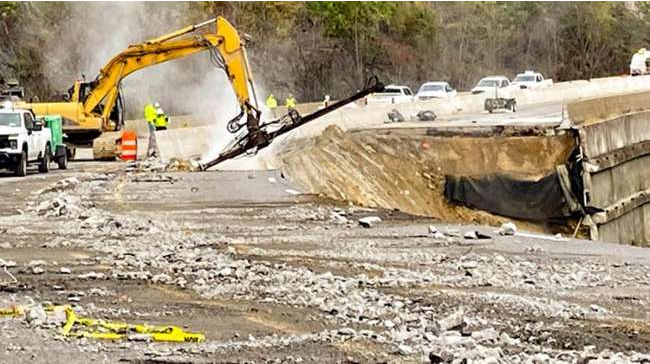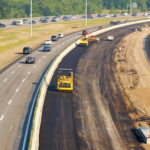Interstate 40 could reopen between North Carolina and Tennessee by New Year’s Day, though traffic will likely move more slowly than normal through the Pigeon River Gorge, per the North Carolina Department of Transportation.
A section over a mile long on I-40’s eastbound side was washed out by Hurricane Helene, so traffic will be restricted to a single lane in each direction on the westbound side. These lanes will be 11 feet wide, a foot narrower than standard, with a speed limit of 40 mph.
The reopening depends on contractors finishing the stabilization of the westbound lanes and installing a concrete barrier in the middle. The $8.5 million stabilization project is set to be completed by January 4.
NCDOT has determined that running traffic on the westbound lanes will allow contractors enough space to repair the damaged eastbound lanes.
Steady progress is being made on Interstate 40 through the Pigeon River Gorge with 2-way traffic anticipated by New Year's Day.
— NCDOT (@NCDOT) November 6, 2024
📗 Read Details: https://t.co/4MUkstwpt5 pic.twitter.com/tWv83ckXlF
“We are working to open I-40 when it is safe, and it will be tight conditions for everybody,” Wanda Payne, NCDOT’s Division 14 Engineer, said in a written statement. “But if everybody is patient, everybody can get through.”
I-40 will be reduced to a single lane in each direction for a nine-mile stretch—five miles in North Carolina and four in Tennessee, where parts of the eastbound lanes were also washed out. Tennessee switched its four-mile stretch to two-way traffic last month, though the interstate is only open up to the last exit within the state.
It’s still uncertain how long this two-way traffic setup will last. NCDOT has selected a team of contractors to plan and rebuild the eastbound lanes, though they haven’t finalized an approach yet.
“Everybody has been coming up with ideas, and all good solutions are still on the table,” Payne said. “We will collaboratively choose the best long-term solution.”
On September 27, the Pigeon River, swollen with floodwater, eroded its banks, damaging the eastbound lanes of I-40 in about ten spots in North Carolina and several more in Tennessee.
Contractors are working to stabilize the westbound lanes using a method called “soil nailing.” This process involves driving long steel rods into the bedrock beneath the road, filling them with grout to bond them to the rock, and then spraying concrete on the cliff face to secure the rods and form a sturdy wall.
When I-40 reopens, NCDOT will station tow trucks in the gorge to quickly remove any vehicles that break down or are involved in crashes within the travel lanes.
Though speeds will be lower and delays may occur, reopening I-40 will restore an essential route for people and freight moving through the mountains, according to Payne.
“Like many things in our area, it will not be like it was for a long time,” she said. “But it will be better than we’ve had in recent weeks.”
Flooding from the remnants of Hurricane Helene cut off all interstate routes between North Carolina and Tennessee. Besides I-40, Interstate 26 was also closed at the state line after two bridges collapsed into the flooded Nolichucky River in Erwin, Tennessee.
I-26 reopened on October 30 after the Tennessee Department of Transportation constructed a temporary causeway over the river, allowing repairs to the bridge to proceed. Traffic on this section is limited to one lane in each direction, with restrictions in place for vehicles wider than 10 feet or overweight, which must continue to detour via Interstates 81 and 77.





